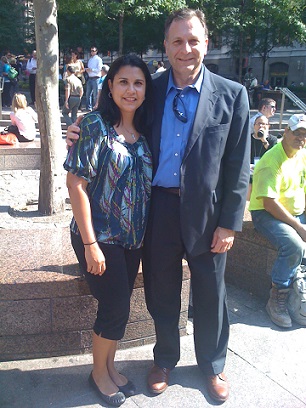Although Richard Eichen and Lucy Gonzalez both worked on the 90th floor of the North Tower, they were strangers before September 11, 2001. On that day, the pair evacuated the building together, escaping its collapse by seconds. Ten years later, on September 12, 2011, the two, along with other 9/11 survivors, reunited for the first time under the Survivor Tree at the 9/11 Memorial.
Eichen, a consultant at Pass Consulting Group, had started working at the World Trade Center in early September 2001 and didn’t yet have a key to the office suite. On the morning of 9/11, he was waiting near the 90th floor elevator for his colleague to arrive when he heard a loud bang and was hurled to the ground as the office erupted in flames.
Despite sustaining a severe head wound, Eichen found his way to an adjacent office where he connected with four others, including Lucy Gonzalez. They decided to evacuate as the smoke billowed and they saw large severed pieces of the building falling outside. However, Gonzalez was reluctant and wanted to wait for first responders.
“I told her, ‘Lucy, we’re not leaving anybody behind. We got to get out of here, we’re starting to burn,’ Eichen remembers. "I took her hands, and put them on my shoulders, and I held them so she wouldn’t let go.”

Overcome with anxiety, Gonzalez fainted near the 25th floor on their decent down the stairs. After FDNY firefighters revived her with oxygen, Eichen grabbed Gonzalez and yelled, “wounded coming through!” and descended the final flights of stairs. The building collapsed minutes after they exited.
Leaving Gonzalez with paramedics, Eichen walked to Downtown Beekman Hospital to seek treatment for his head wound. In the waiting room, he first learned of the terrorist attacks from the news. Still bloody, wearing his hospital gown and a bandage wrapped around his head, Eichen discharged himself and walked over the Brooklyn Bridge toward his parents’ home in Rockaway, Queens. After he crossed the bridge, a stranger offered him a ride and he soon was reunited with his parents.
Weeks later, he tried to locate Gonzalez. Finally able to connect through email, he confirmed that she was okay. It was not until 10 years later that the two decided to reunite and confront their memories together.
They met at the then-newly-dedicated 9/11 Memorial under the Survivor Tree at a special event for survivors. “I really believe the beauty and peace of the memorial affected everyone there,” Eichen said.
By Jenny Pachucki, 9/11 Memorial Content Strategist